Hey! How was I supposed to know Waves shouldn’t be on an island, and Houses shouldn’t be in the see? This is written nowhere in the rules!
More seriously, common sense helps in this game, but it may be a false friend: for instance, I was placing beaches inside the island at the beginning.
By the way, if the rule was to place beaches inside the island and to score +1pt per side touching the sea, players would be encouraged to add “convex sections” (peninsulas sticking out) on their islands rather than “concave sections” (cavities). I think it shows in the most successful maps.
I don't think it would be hard to translate to boardgame form - cards with the piece up the top and locations you could place it down the bottom would be easily readable, and you could use a pad of paper to ink in the piece. Same with the borders.
(56 on my first try, random... 50 on my most recent)
Really nice game! Scoring system is tough to remember at start but soon you get hang of placing the tiles. Design of the game is very well thought and quite unique:)
I love it! Would be great to be able to play it on my phone, but even if it was supported I don't think my screen is big enough that it would be satisfying. But I'm loving it on my laptop anyways.
I would also love to play this as a physical game, and I think it would work amazingly well as a competitive two-player game where each player is using their own board but are picking cards from the same pool.
Its a lot of fun to surround mountains with forests, knowing you'll get two big point boosts.
I love having a choice that seems equal, but choosing one tile over another in the hopes that the perfect card will appear and bag me some extra points. For example placing a forest that almost connects two forests for instance and then having another forest appear that lets me connect them and rewards my optimistic thinking.
Houses are great! They give this extra meaning to every other card, tying everything together and rewarding you for careful placement. Fantastic design.
I think having only two cards which each give you very restricted choices is right. I was worried at first that this game wouldn't be as relaxing as the art style and concept suggested, and I think without this heavily restricted choice it might be. If my islands don't work out I don't feel stupid - the deck just wasn't stacked in my favour.
The Bad
Some of the rules were unclear. All my friends and I were unsure of "near" and forests "touching" when we first played. The boats also still confuse me. They don't care about diagonals as much as you think they should.
My friends and I have noticed we often have two nice islands and finish the game by drawing an empty and sad third island. It's a strange feeling to end the game like that. Maybe making the islands smaller would force you to use the third island more often? Or maybe just letting the player skip drawing a third island would solve it.
Check out this zero point boat. The gray search area filled up the board, but it didn't show any points.
I've seen people putting a lake inside an island, and calling it an island inside an island. This is a real island inside an island. Good challenge to try and complete it without any penalties.
A fun variant is trying to score zero points without penalties. So no beaching boats on an island, leaving houses in the sea, etc. Not as easy as it sounds!
The only problem is you can't play boats because they always score at least 1 point in the sea. If it doesn't mess up the balance, a better rule for boats might be "1 pt for each square away ... minus 1 pt" like forests. Maybe with a bonus point for each square beyond say 5.
In _two_ games now I've been given the exact same choice when offered two tiles. Thus, instead of two choices, I've had no choice whatsoever. This is kinda frustrating. Is this something you want the game to do? Couldn't you have the game compare the two tile choices before it presents them to the player, and if the choices are exactly the same, the game (randomly) regenerates one of the tiles (and compares again), repeating this until two unique tile-choices are determined? Then _those two choices_ are offered the player?
Thanks for the feedback. I modelled the game with the intention that it could be replicated as a physical tabletop game. The tiles are shuffled and dealt just as you would a deck of cards. Sometimes the shuffle will end up like this, with two identical tile options. I haven't personally found it an issue, but will keep it in consideration for future developments. Thanks again.
It has that fun sorta Carcassonne feel, yeah. I'd like to make a game somewhere in the region of this style too. I love building a land as you play. :D
I wanted to show my friends in the pub what I am doing in my free time. Unfortunately the page is not optimized for mobile view. I know that not all phones support WEBGL, but I think it is kind of easy to set up anyway.
These settings in the game page work fine for me.
If that is not enough, changing the UI canvas default viewport and scaling in Unity should do the trick.
Will have a look, I feel there may be some knock on issues with usability within the game. The interface is designed with mouse in mind rather than touch screen. Thanks for the info.
Im interested in the algorythms. Is it just odds or does it use a System with limited cards? And if yes how much cards there are of each biom and position
Cards work as they would in a physical version, with fixed fronts (type) and backs (position) this remains the same for every game. The deck is shuffled each time.
Does this imply, that not every field has the identical probability to offer e.g. a boat? There are only 3 positions (back) containing a boat?
If yes, knowing all the cards and thereby possible locations of certain types will drastically raise your outcome.
Or isn't a certain front sticked to a certain back, meaning in fact you have to separate decks: one for the types and one for the position and their combination is random.
For each of the 81 cells of the grid the possibility of it being used for a specific card is not identical but it is reasonably close.
Each card has a position on the back side of it. It is not possible for the back and front of a specific card to appear at the same time in the game, just like a real card.
If you only look at the back of the 54 cards each cell in the grid has 9 total chances to be used (three for each the row, column and section. 3 x 3 = 9). So any single specific card takes nine of those cells and reduces the opportunities of them being used to 8 (as those options are on the back of that card). So the opportunities of a cell being used for a specific card is 8/54 for 9 of the cells and 9/54 for the other 72 cells.
This is all further complicated by multiple cards having the same card type on their front, which tweaks the odds again.
The reason there is only a single deck of cards with fronts and backs, is that it would reduce the manufacturing cost in a physical game, which is what I was modelling. Two decks would allow the cells possibility of being used for a specific card equal.
There are more forest cards than any other terrain, so: Yes, forest give the most points.
But! You get exactly 26 (pair of) cards, so it is about using them as best as possible.
You have 11 Forests for 27 points, that is approximately 2½ point pr. forest.
You have 2 Mountains for 12 points, that is 6 points pr. mountain.
You have 1 Church for 10 points!
In reality it is about combining the terrain types so they give points, and here forest are slightly better due to there are more of them, and thus they are more chances to place forests so they generate points.
← Return to game
Comments
Log in with itch.io to leave a comment.
Hey! How was I supposed to know Waves shouldn’t be on an island, and Houses shouldn’t be in the see? This is written nowhere in the rules!
More seriously, common sense helps in this game, but it may be a false friend: for instance, I was placing beaches inside the island at the beginning.
By the way, if the rule was to place beaches inside the island and to score +1pt per side touching the sea, players would be encouraged to add “convex sections” (peninsulas sticking out) on their islands rather than “concave sections” (cavities). I think it shows in the most successful maps.
My first game I scored 1! Would play again
Hard game but very well designed. I recommend playing this when you need to kill time.
Wow 0 points on first try, i didn't understood it really but now I do nice game tho
Well on the 2nd try 43 points not bad
Small game, good game!
Really enjoyed the experience. I would love to play some sort of boardgame version of it. Too bad it dosen't have sound or music, tho!
55 on my first try! (But from that point on, it went worse haha)
I don't think it would be hard to translate to boardgame form - cards with the piece up the top and locations you could place it down the bottom would be easily readable, and you could use a pad of paper to ink in the piece. Same with the borders.
(56 on my first try, random... 50 on my most recent)
really nice. thanks for your effort !
51 Points in first try. Random
Great!
Nice design! tiny and graceful game.
Very nice :)
Add basic colors to the game only with green grass and brown mountains would be quite beautiful :3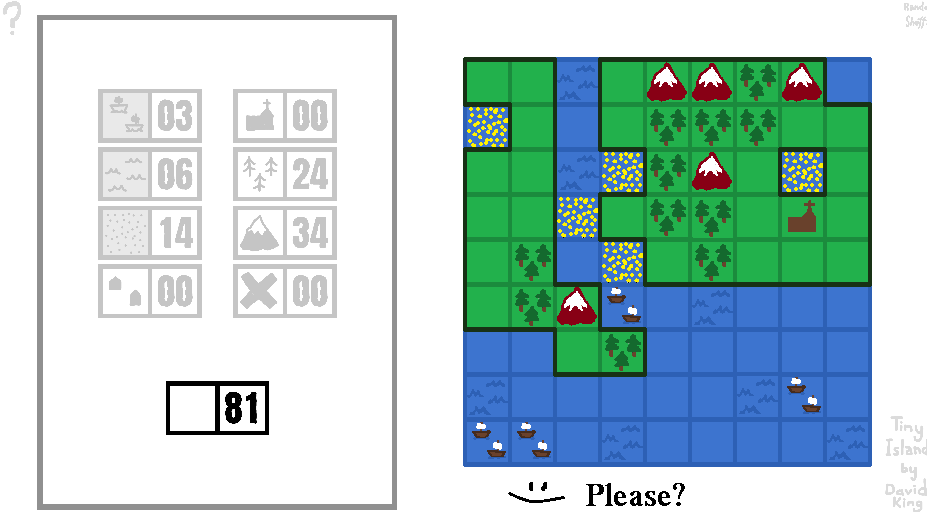
YES!!
Awesome!
really fun and challenging... but i got only 0 points in 2 attempts
Really fun an creative game! Loved it
This may not be a huge score, but after MONTHS of topping out in the 60's and 70's, this first break into the 80's feels GREAT!
I was looking for a relaxing yet challenging game. Then I found this and absolutely loved it !
Nice game!! My highest is just 55!
Really nice game! Scoring system is tough to remember at start but soon you get hang of placing the tiles. Design of the game is very well thought and quite unique:)
For anybody wondering what happens after 99 ... the square expands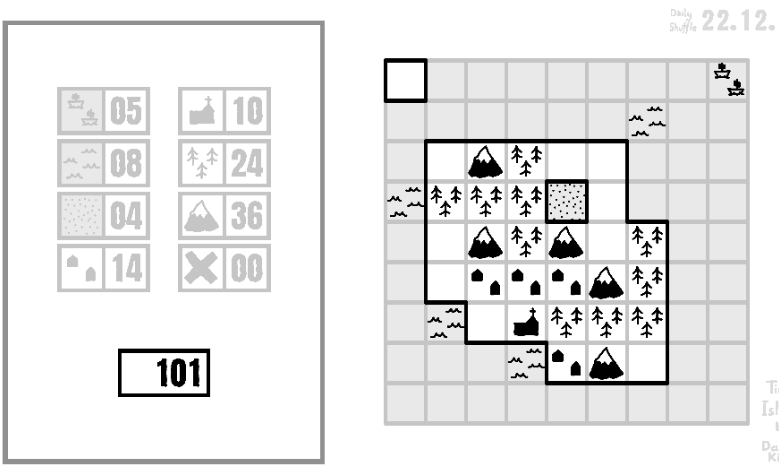
Holy cow, that's ridiculously impressive!
Yay I got 76
ipad version would be HELLA nice, then I would like to colour them in afterwards.
I love it! Would be great to be able to play it on my phone, but even if it was supported I don't think my screen is big enough that it would be satisfying. But I'm loving it on my laptop anyways.
I would also love to play this as a physical game, and I think it would work amazingly well as a competitive two-player game where each player is using their own board but are picking cards from the same pool.
iPhone game would be great --> iOS port
After the final count it would be nice to see the score for each square.
How about some diagonal tiles in the game, running from corner to corner?
That, or some "picket fence" tiles that go either horizontally or vertically but running in a sort of 'cross-hatched' (herringbone) pattern?
Some feedback from my friends and I:
The Good
Its a lot of fun to surround mountains with forests, knowing you'll get two big point boosts.
I love having a choice that seems equal, but choosing one tile over another in the hopes that the perfect card will appear and bag me some extra points. For example placing a forest that almost connects two forests for instance and then having another forest appear that lets me connect them and rewards my optimistic thinking.
Houses are great! They give this extra meaning to every other card, tying everything together and rewarding you for careful placement. Fantastic design.
I think having only two cards which each give you very restricted choices is right. I was worried at first that this game wouldn't be as relaxing as the art style and concept suggested, and I think without this heavily restricted choice it might be. If my islands don't work out I don't feel stupid - the deck just wasn't stacked in my favour.
The Bad
Some of the rules were unclear. All my friends and I were unsure of "near" and forests "touching" when we first played. The boats also still confuse me. They don't care about diagonals as much as you think they should.
My friends and I have noticed we often have two nice islands and finish the game by drawing an empty and sad third island. It's a strange feeling to end the game like that. Maybe making the islands smaller would force you to use the third island more often? Or maybe just letting the player skip drawing a third island would solve it.
Check out this zero point boat. The gray search area filled up the board, but it didn't show any points.
Thanks for the feedback, really appreciate it.
I didn't actually say, but it's a great little game. I love the design. Well done and thanks for the perfect five minute break between study sessions.
You can always make "lakes" instead of the 3rd island right?
(see comment below)
I've seen people putting a lake inside an island, and calling it an island inside an island. This is a real island inside an island. Good challenge to try and complete it without any penalties.
Nice!
I had no idea you could use the lines to carve out the inside of an island! That's a fun challenge!
Mountain kingdom
WHHAAAAT!!? I didn't know you could draw an island inside of another!
I know! A well known secret :)
I saw someone doit earlier in this thread.
You can draw one big island with a lake inside it and a tiny island in the middle.
I freaking love this game.
<3

Simple & Fun !
but now, I can go to sleep !
Very lucky random shuffle!
First try on the daily shuffle!!
A fun variant is trying to score zero points without penalties. So no beaching boats on an island, leaving houses in the sea, etc. Not as easy as it sounds!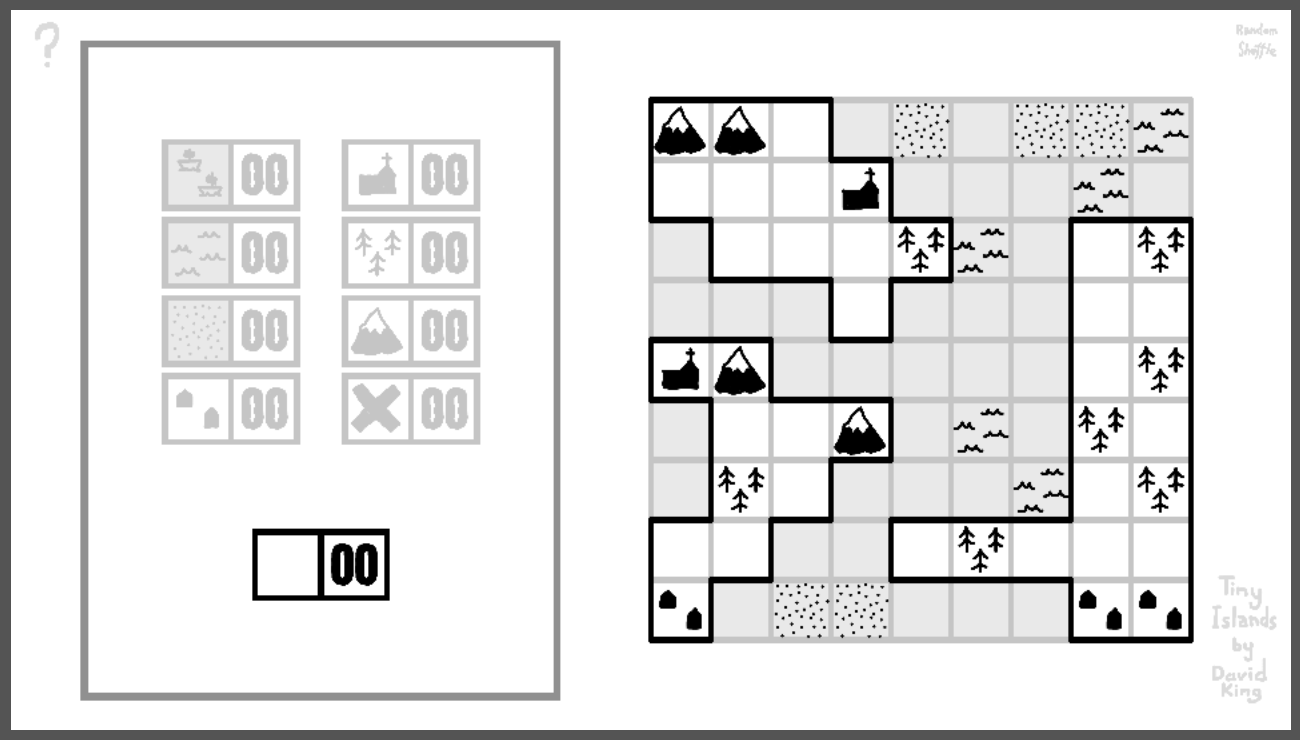
I like this.
The only problem is you can't play boats because they always score at least 1 point in the sea. If it doesn't mess up the balance, a better rule for boats might be "1 pt for each square away ... minus 1 pt" like forests. Maybe with a bonus point for each square beyond say 5.
I love this variant more than the actual game! Thank you for the suggestion, bundtcake!
In _two_ games now I've been given the exact same choice when offered two tiles. Thus, instead of two choices, I've had no choice whatsoever. This is kinda frustrating. Is this something you want the game to do? Couldn't you have the game compare the two tile choices before it presents them to the player, and if the choices are exactly the same, the game (randomly) regenerates one of the tiles (and compares again), repeating this until two unique tile-choices are determined? Then _those two choices_ are offered the player?
Thanks for the feedback. I modelled the game with the intention that it could be replicated as a physical tabletop game. The tiles are shuffled and dealt just as you would a deck of cards. Sometimes the shuffle will end up like this, with two identical tile options. I haven't personally found it an issue, but will keep it in consideration for future developments. Thanks again.
It has that fun sorta Carcassonne feel, yeah. I'd like to make a game somewhere in the region of this style too. I love building a land as you play. :D
I wanted to show my friends in the pub what I am doing in my free time. Unfortunately the page is not optimized for mobile view. I know that not all phones support WEBGL, but I think it is kind of easy to set up anyway.
These settings in the game page work fine for me.
If that is not enough, changing the UI canvas default viewport and scaling in Unity should do the trick.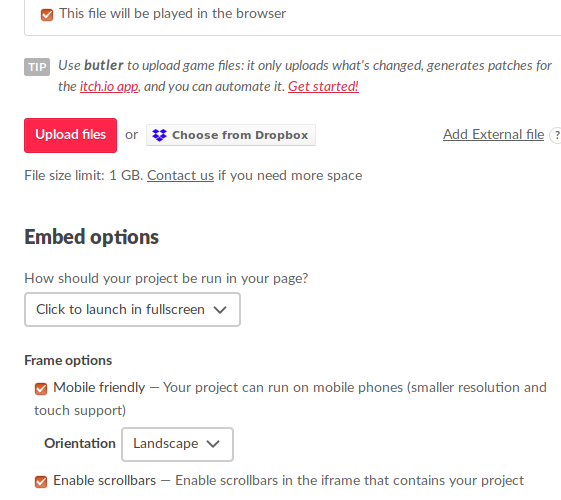
Will have a look, I feel there may be some knock on issues with usability within the game. The interface is designed with mouse in mind rather than touch screen. Thanks for the info.
Are we creating islands for another game you are making?
If so, it's gonna be massive! Can't wait to play it ;)
Now that's an idea!
Best random shuffle yet!
Im interested in the algorythms. Is it just odds or does it use a System with limited cards? And if yes how much cards there are of each biom and position
Cards work as they would in a physical version, with fixed fronts (type) and backs (position) this remains the same for every game. The deck is shuffled each time.
There are:
13 Trees, 10 Houses, 9 Beeches, 9 Waves, 5 Mountains, 5 Churches, 3 Boats
There are an even number of each of the position backs.
Does this imply, that not every field has the identical probability to offer e.g. a boat? There are only 3 positions (back) containing a boat?
If yes, knowing all the cards and thereby possible locations of certain types will drastically raise your outcome.
Or isn't a certain front sticked to a certain back, meaning in fact you have to separate decks: one for the types and one for the position and their combination is random.
For each of the 81 cells of the grid the possibility of it being used for a specific card is not identical but it is reasonably close.
Each card has a position on the back side of it. It is not possible for the back and front of a specific card to appear at the same time in the game, just like a real card.
If you only look at the back of the 54 cards each cell in the grid has 9 total chances to be used (three for each the row, column and section. 3 x 3 = 9). So any single specific card takes nine of those cells and reduces the opportunities of them being used to 8 (as those options are on the back of that card). So the opportunities of a cell being used for a specific card is 8/54 for 9 of the cells and 9/54 for the other 72 cells.
This is all further complicated by multiple cards having the same card type on their front, which tweaks the odds again.
The reason there is only a single deck of cards with fronts and backs, is that it would reduce the manufacturing cost in a physical game, which is what I was modelling. Two decks would allow the cells possibility of being used for a specific card equal.
At least I think that's right.
The game is really fun! I found out that the forests are more likely to get you more points than other items.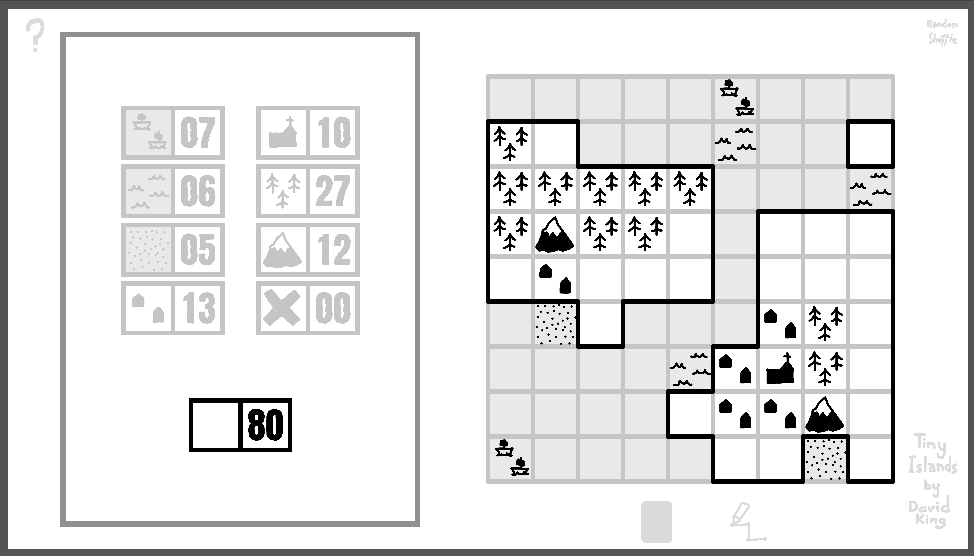
There are more forest cards than any other terrain, so: Yes, forest give the most points.
But! You get exactly 26 (pair of) cards, so it is about using them as best as possible.
You have 11 Forests for 27 points, that is approximately 2½ point pr. forest.
You have 2 Mountains for 12 points, that is 6 points pr. mountain.
You have 1 Church for 10 points!
In reality it is about combining the terrain types so they give points, and here forest are slightly better due to there are more of them, and thus they are more chances to place forests so they generate points.
Oh sweet! I don't have to wait a day for it to shuffle anymore!
And another go:
Surely a beach in the middle of your island doesn't count, that's just a desert xD
Clever though, didn't realise that was possible.
What's the best you can do on Random Shuffle?